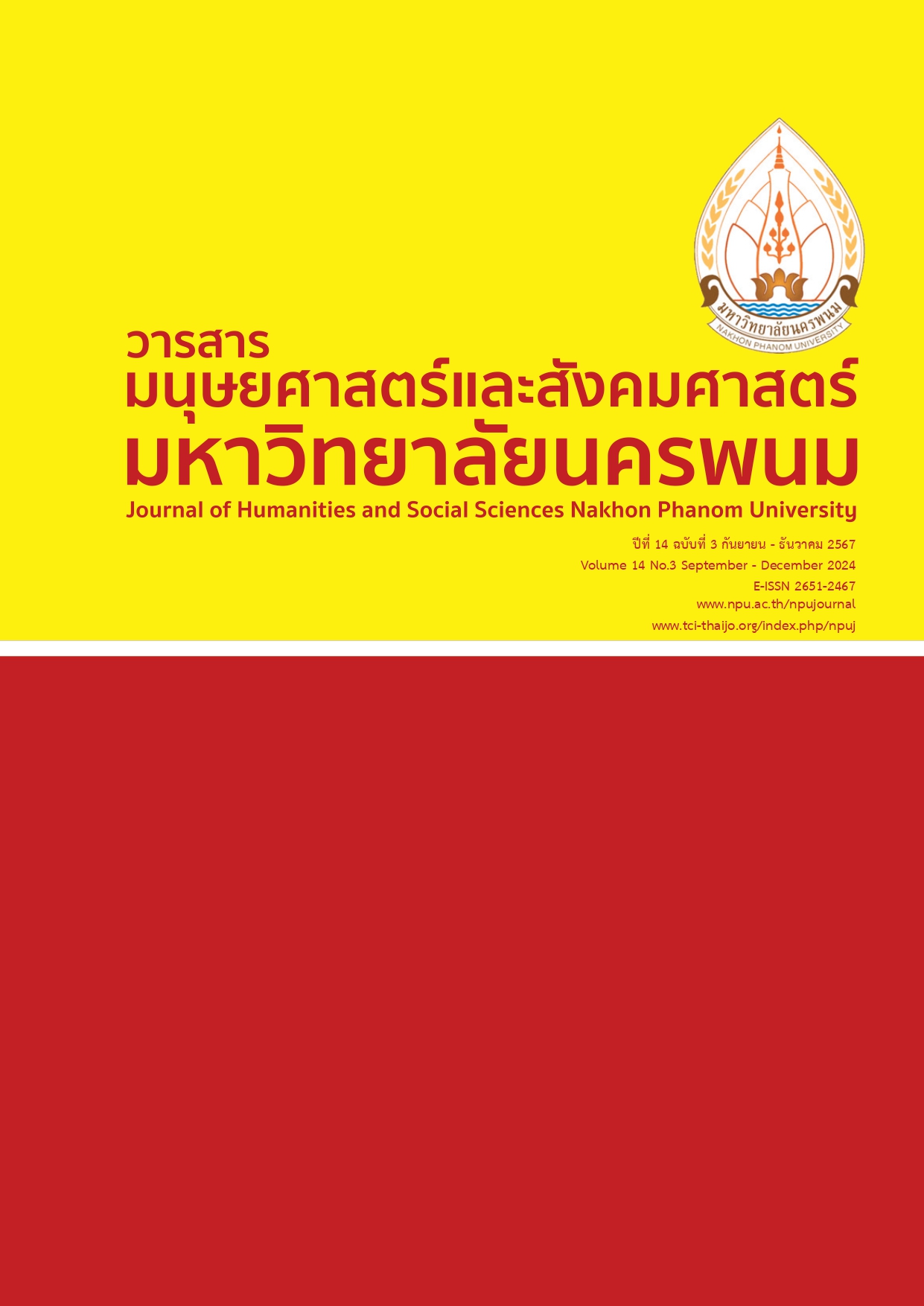Designing and Branding for Local Textile Community Enterprises in Kanchanaburi Province to Support Digital Platforms Usage
Main Article Content
Abstract
This research aimed to investigate entrepreneurs and tourists’ brand needs, design the brand, evaluate the brand's effectiveness by experts, and assess entrepreneurs and tourists’ satisfaction. The study adopted a mixed-method research approach.The research target consisted of 11 groups of textile community enterprises in Kanchanaburi province and tourists who had previously purchased or used local textiles. The key informants included 4 textile enterprises from each of the 4 districts using purposive sampling selection, and the infinite tourists were sized based on Yamane's formula; the sample size included 385 participants for the needs survey and 120 participants for the satisfaction assessment, totalling 505 participants. The instruments consisted of 1) interview forms, 2) questionnaires, and 3) brand performance and satisfaction evaluation forms.Data from interview was analyzed descriptively, and data from the questionnaires was analyzed using descriptive statistics, including mean, percentage, and standard deviation. The criteria for evaluating brand effectiveness and satisfaction, included the brand name, logo design, typography, color scheme, and application. The research findings were as follows: 1) The branding needs of each enterprise were ranked as follows: Lao Khwan and Huai Krajao districts preferred a community-based brand name, Tha Muang district preferred to retain its original name, and Thung Samo district preferred the name of its founder. Tourists showed a high level of demand for brand names, with an average score of 4.18. 2) "Lao Khwan Woven Fabric" for Lao Khwan district, "Benjapilai" for Huai Krajao district, "Pha Khao Ma Areerat’s Hundred-Colored" for Tha Muang district, and "Taya" for Thung Samo district. 3) The overall brand effectiveness evaluation was at high levels, with average scores of 4.01, 4.12, 3.80, and 3.99, respectively. 4) Overall tourist satisfaction with the brand was at the highest level, with average scores of 4.74, 4.52, 4.57, and 4.60, respectively.
Article Details

This work is licensed under a Creative Commons Attribution-NonCommercial-NoDerivatives 4.0 International License.
References
Aaker, D. A. (1991). Managing brand equity. The Free Press : New York.
Aaker, J.L.(1997).Dimensions of brand personality.Journal of Marketing Research, 34(3),347-356. doi:https:// doi.org/10.2307/3151897
Arunnayanak, J. (2017). Principles of communication design using computers. Bangkok : Chulalongkorn University.
Boonsomthop, P. (2020). Graphics for communication arts. Kanchanaburi: Kanchanaburi Rajabhat University.
Chaiarayalert, S., Suttapong, K. & Kongrit, V. (2021). Enhancing the potential of SMEs through digital economy strategies: A case study of the Southern Thai traditional woven fabric community enterprise. Retrieved October 2021, from https://elibrary.trf.or.thproject_content.asp?PJID=RDG5950100
Chatthanannon, A. & Leelayutthayothin, L. (2024). Building brand image: A strategic tool for winning a current marketing war.Retrieved October 2024, from http://www.jba.tbs.tu.ac.th/files/Jba105/Article/ JBA105Apisit.pdf
Department of Industrial Promotion. (2021). Product branding. Retrieved October 2021, from https://bsc.dip. go.th/th/category/sale-marketing/sm-buildingtrademark
Fastwork. (2021). Brand-building techniques for starting a business in 2021. Retrieved February 2023, from https://www.fastworkbusiness.com/branding-for-business/
Kanchanaburi. (2023). Kanchanaburi: General information. Retrieved December 2023, from https://www.
kanchanaburi.go.th/au/travel/kanintro.php
Kapferer, J., N. (2004).The New Strategic Brand Management: Advanced Insights and Strategic Thinking (New Strategic Brand Management: Creating & Sustaining Brand Equity). (5th ed.). London : Kogan Page.
Kasikorn Bank. (2022). 4 marketing strategies that SMEs need to know. Retrieved August 2023, from https://www.kasikornbank.com/th/business/sme/KSMEKnowledge/article/MarketingTips/Pages/SMEMarketingStrategies.aspx
Kongkaem, N. (2016). Purchasing Behavior of Users of the Shopee Application in Thailand. Nakornphathom: Silpakorn University.
Kotler, P. (2000). Marketing management. New Jersey : Prentice Hall.
Lanchanon, P. (2005). Principles of marketing. Bangkok : Chulalongkorn University.
Litwin, G. H. & Stringer, R. A. (1968). Motivation and organisational climate. Boston : Division of Research, Harvard Business School,
Lupton, E. (2017). Type on screen. Nonthaburi : IDC.
Ministry of Tourism and Sports. (2023). Domestic tourism situation by province, 2022. Retrieved January 2023, from https://www.mots.go.th/news/category/657
Nuambang, K., Jesadalak, W. & Amphawat, K. (2022). Antecedents and consequences of new brand awareness: Empirical evidence of new branded products. Panyapiwat Journal, 14(1),58-70.
Office of Industrial Product Standards. (2021). List of certified community product quality recipients in Kanchanaburi Province. Retrieved October 2021, from http://tcps.tisi.go.th/public/
Office of Small & Medium Enterprises Promotion. (2021). Report on the situation of small and medium enterprises 2021. Retrieved October 2021, from https://sme.go.th/upload/mod_download
/download-20210825104100.pdf
Onebelieve. (2022). Marketing: Definitions, product presentations, and basic marketing techniques. Retrieved August 2022, from https://www.1belief.com/article/marketing/
Rocket Blog. (2024). What is brand awareness? share techniques to create a memorable brand. Retrieved June 2024, from https://www.rocket.in.th/blog/brand-awareness/.
Rokeach, M. (1973). The nature of human values. : New York : Free Press.
Ruangprapan, C. (1996). Basic Statistics. Khon Kaen : Faculty of Science, Khon Kaen University.
Seo, M.(2020). Logo and packaging design for the jackfruit large plot community enterprise, Nonghiang subdistrict, Phanatnikhom district, Chonburi province. Chonburi : Burapha University.
Sukkorn, K., Lukkha, N. & Santhan, B. (2012). Design of logos and packaging for Thai clay craft products of the Thai Clay Craft Group, Nonthaburi Province. Bangkok : Suan Sunandha Rajabhat University.
Taveerat, P. (1997). Research methods in behavioral and social sciences. (7th ed.). Bangkok : Educational and Psychological Testing Bureau, Srinakharinwirot University Prasarnmit.
Thaiger. (2021). What is a brand? and what a brand is definitely not. Retrieved October 2021, from https://thaiwinner.com/what-is-brand/
Thailand Textile Institute. (2021). The situation of the thai textile and garment industry. Retrieved October 2021, from https://www.thaitextile.org/th/insign/detail.2292.1.0.html
Thanaboonnipat, P. (2021). Adding value to traditional Southern Thai woven fabrics. Retrieved October 2021, from https://researchcafe.org/southern-woven-fabric/
Thanaporn, K. (2021). Case Study: Why shopee is the fastest growing e-commerce platform in Southeast Asia. Retrieved June 2024, from https://thegrowthmaster.com/case-study/shopee
Thongtrachou, P., Rattanaphan, M., Suwan-on, K., Rattanaphan, P., Thongpoon, S., Methanai, C. & Meebun, C. (2022). Brand and label design for rice products of ban thasae rice farmers group, tambon khlong u ta phao, amphoe hatyai, songkhla, The 13th Hatyai National and International Conference, Thailand.
Vanichbuncha, K. (1999). Statistical analysis: Statistics for decision making. (4th ed.). Bangkok : Chulalongkorn University.
Wattanavarungkul, U. (2020). Marketing mix and motivation towards purchasing decisions on sulwh asoo facial skin products in the Bangkok metropolitan area (Unpublished master’s Independent Study). Srinakharinwirot University, Bangkok, Thailand.
Yamane, T. (1973). Statistics : An Introductory analysis. New York : Harper and Row.


